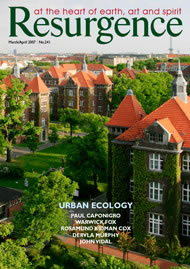BOTTLED WATER COSTS more than petrol and yet most of us flush around 50 litres of drinking water down the loo every day. Fifty litres is a tank of petrol. The water in our lavatory cisterns is as clean as that in the heavily marketed and transported bottles that line our supermarket shelves, but we are as careless of tap water as of fresh air. How can we be so inconsistent? On one level we venerate water with Evian and sacred wells; on another we treat it as a national nuisance that falls
unbidden from the sky, spoiling our shoes and holidays.
The link between flood and drought is seldom made. If the British are ever at a loss for words, we can always fall back on a reassuring lament about too much or too little rain. And yet, as weather patterns become more erratic, as we pave over more and more fields and front gardens, and as we desire more powerful showers and greener lawns, we need to understand that connection between drought and flood.
The freshwater cycle has a natural pace. Fresh water falls as rain or snow, is absorbed into the ground and flows down through rivers to the sea to evaporate and return again as rain. It irrigates our lives on its way. Only 1% of the Earth’s water is usable for drinking and it steadily recycles at its own rate. As we accelerate that rate, the water has less chance to sink into the ground; it rushes over the land, taking soil, nitrates and pollutants with it, floods into riverside towns, overflows sewers, and then is sped out to sea, leaving contamination, destruction and… no water. We don’t particularly need more water; we just need to
slow it down and treat it with a little more respect.
So where can we make a start in Britain? Rural land management would be a good place. Farming practices since the war have been to encourage maximum food production. Among other things this has been achieved by bringing marginal land into use, often draining wetlands, clearing wooded slopes, straightening rivers and embanking flood meadows. With the reconfiguration of the Common Agricultural Policy, there is the opportunity to repair a more patient pattern of land management. Rainwater can be recaptured in upland woodlands and wetlands, gradually released into meandering rivers and stored at times of peak rainfall in flood meadows and marshes. Run-off, erosion and diffuse pollution can be reduced by softer, slower and more traditional ways of using the land. Even surfacing roads and motorways with porous asphalt could make a big difference to polluted run-off, as well as to traffic noise. At the moment the water companies spend up to £313 million a year dealing with nitrates, pesticides and other contaminants – 10% of the costs of supplying drinking-water to the public in England and Wales. The clean-up uses both chemicals and energy-intensive ultra-violet treatment, contributing to the water industry being the most power-hungry of utilities and emitting 2.6% of UK carbon emissions every year. These resources could be allocated more efficiently and more wisely by tackling the pollution at source, and indeed some water companies have bought critical upland sites within their catchments to allow the water to soak naturally and cleanly through wetlands and forests to the rivers. This is connected thinking at its best. The scope of the new Single Farm Payment system and the EU Water Framework Directive could bring farming and water conservation into timely harmony. It will rely on an agile and imaginative Defra (Department for Environment, Food and Rural Affairs) to pay farmers to produce food in a way that works for water, wildlife and landscape.
The opportunity and the urgency are here in a way that has not been evident for half a century and could revolutionise the way we think about our rural land. As the aquifers of Mediterranean countries deplete to crisis levels, importing Italian salads and Spanish strawberries to the UK becomes less viable. Agriculture in northern Europe should be set for a serious revival. Growing food sustainably in mild rain-fed climates is a good idea. Farmers and water companies have said that they would welcome the shift and it would return agriculture to something purposeful, positive and relevant. The general drift over the last ten years towards treating countryside as a kind of suburban park, with farmers as subsidised park-keepers, is one that neither taxpayers nor the environment can afford.
Then there are the towns and cities where 90% of us live. This is often where the crisis is felt: where hosepipe bans hit first and where floods are most devastating. According to the Government’s Chief Scientist, the number of people at high risk of flooding is expected to more than double to nearly 3.5 million by 2080. Housing pressure in South East England means that new estates continue to be built in areas that are intrinsically short of water and prone to flooding. In the last year twenty-one major developments have been built on flood-plains despite explicit appeals from the Environment Agency, and in direct contravention of national policy. Apart from waking up the planning system to make sure that this kind of madness does not continue, what else can be done? Is there anything that we can do as individuals that has any effect? Actually there is rather a lot. The Germans manage to lead perfectly comfortable lives while consuming a third less water than the English. Dual-flush loos, water butts, drip irrigation rather than sprinklers, and parking areas made of permeable gravel rather than impermeable tarmac, are some of the small changes that can make a big difference. The revival of public parks and private gardens as places that help to absorb and store water could have a direct effect that would reduce the need for massive flood and supply engineering schemes and the energy to keep them running.
The next biggest consumer of water, after houses, is the energy industry. Power station cooling accounts for 39% of national water consumption. One of the ironies of a drought order is that power stations like Didcot could be shut down as the flows in the river Thames become so low that water cannot be drawn off to cool the installation. Although the structural upheavals would be enormous, one of the great attractions of decentralising energy generation is the scope for combining power infrastructure with recycling heat, water and sewage at a local level. A number of water companies have already built sewage works where they siphon off the methane for energy and sell the dried ‘waste’ as fertiliser. The more that waste is eliminated as a concept and imaginative lateral thought is applied to how we use and reuse all our resources in combination, the better. Reducing the distances travelled by both water and energy makes as much sense as reducing the distances travelled by food.
Worldwide, water shortage and flooding are in the vanguard of climate change. Our urban and rural lives have been too careless of the resource, relying on easy water from ancient aquifers – stored under the ground over thousands of years – rather than renewable water from the freshwater cycle. In the United Kingdom of all places, it must be possible to find a sensible way of managing water. Rather than alternating between drought and flood, we need to press for political courage to regain balance, using water carefully and slowing down its journey from sky to sea.







